Germany’s Hidden Historical Treasure
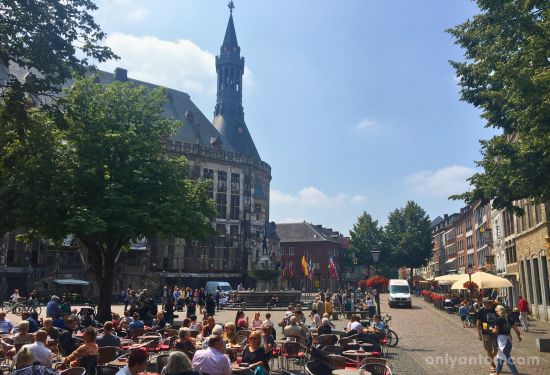
Introduction
Welcome to your ultimate Aachen travel guide! Nestled at the crossroads of Germany, Belgium, and the Netherlands, this hidden gem defies the typical tourist path. Offering a blend of rich history and vibrant culture, Aachen captivates those who venture its way. Known as the preferred residence of Charlemagne and a pivotal medieval city, it invites travellers to explore its unique heritage that stretches from ancient Roman times to a thriving modern-day cultural hub.
This guide takes you through the city’s cobblestone streets where emperors once roamed, hot springs rejuvenate, and architectural marvels like the Aachen Cathedral stand majestically as UNESCO World Heritage sites. From its strategic position in the heart of Europe to its lesser-known culinary delights like the Aachener Printen, Aachen promises a journey through history wrapped in the warmth of its welcoming spas and festive spirit. Whether you’re a history buff, a cultural enthusiast, or simply searching for Europe’s hidden gems, Aachen offers an off-the-beaten-path experience rich with discovery.
Aachen’s Strategic Location: A Hub at the Heart of Europe
Aachen’s position in the westernmost corner of Germany, tucked into the North Rhine-Westphalia region, marks it not only as a pivotal junction within the Meuse-Rhine Euroregion but also as a gateway to unique European landmarks. This unique location enriches Aachen with a multifaceted cultural landscape and makes it an accessible starting point for travellers exploring the heart of Europe.
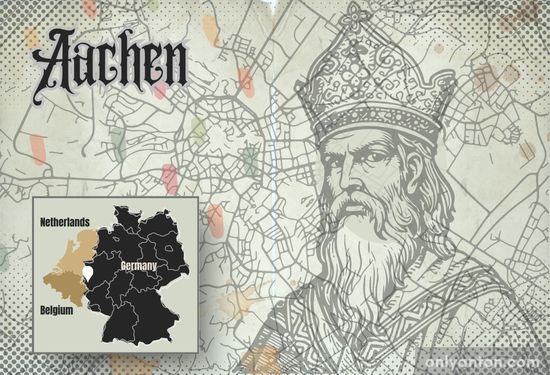
Proximity to Major Cities and Unique Attractions
- Maastricht, Netherlands: About 30 kilometres away, Maastricht can be reached in approximately 40 minutes by car. Frequent trains also connect these two historic cities, making Aachen a convenient day trip from Maastricht or vice versa.
- Cologne, Germany: Approximately 70 kilometres to the east, Cologne is a short one-hour drive away. Direct trains run regularly between Cologne and Aachen, taking about 45 minutes and offering a swift journey through the German countryside.
- Liège, Belgium: Located around 50 kilometres southwest of Aachen, Liège is less than an hour’s drive. Direct trains are available, offering comfortable and quick international travel.
A Gateway to the Drielandenpunt
Just a short journey from Aachen is the Drielandenpunt (“Three Country Point”), where the borders of Germany, the Netherlands, and Belgium converge. This tri-border area is a geographical novelty and a symbol of European unity and cooperation. It features an observation tower, hiking trails, and a labyrinth, making it a compelling side trip for those staying in or passing through Aachen.
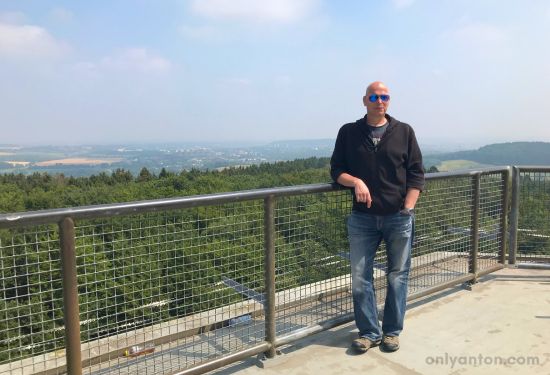
During a personal excursion in July 2019, some family members and I spontaneously visited Aachen after exploring the Drielandenpunt. The decision to divert our plans from Maastricht to Aachen was based on Aachen’s historical ties to Charlemagne and its proximity. In the end, Aachen became one of our extended trip’s most memorable destinations. This experience underscored how Aachen’s strategic location could transform a simple itinerary into an enriching exploration of European history and culture.
Accessibility and Multilingual Environment
The German autobahn network serves Aachen well, efficiently connecting it to various parts of Germany and neighbouring countries. The A4 and A44 motorways make car travel convenient and quick.
Aachen Hauptbahnhof, the city’s central railway station, is a critical hub in the international rail network. It offers extensive services like high-speed ICE, Thalys, and InterCity trains that link Aachen with major cities across Germany and beyond, such as Brussels, Paris, and Frankfurt. Local buses and regional trains provide easy access to nearby attractions and rural areas.
The linguistic landscape of Aachen is notably diverse, reflecting its position as a crossroads in Europe. German is the primary language, but thanks to the city’s proximity to Belgium and the Netherlands, many residents are multilingual, with Dutch and English widely spoken. This abundance of language facilitates a seamless experience for visitors, enhancing Aachen’s appeal as a travel destination that combines convenience with rich historical and cultural experiences.
A Journey Through Time: Aachen’s Rich Historical Legacy
Aachen’s history is as layered and complex as the landscapes surrounding it. It began as the humble Celtic settlement of Aquisgranum (or Aquae Granni) and rose to prominence under Roman rule. The city’s naturally-occurring hot springs have been a tourist draw ever since. These thermal waters, emerging at temperatures up to 75°C (167°F), were revered for their healing properties and marked the city as an early Roman spa destination.
Roman Foundations and Carolingian Splendor
The Romans constructed elaborate thermae, or bath complexes, around these geothermal waters, attracting locals and travellers alike. The remnants of these baths provide a direct link to Aachen’s ancient past. However, it was under Charlemagne, the Father of Europe, that Aachen transformed into a city of great significance. Charlemagne established his Palatine Chapel here in the late 8th century, now part of the iconic Aachen Cathedral, turning the city into the spiritual heart of his empire and a site for the coronation of German kings for centuries.
The Carolus Thermen: Continuing the Spa Tradition
Named after Charlemagne, the Carolus Thermen Bad Aachen modernizes the historical bathing culture with facilities that tap into the ancient hot springs. Rich in minerals, these waters echo the therapeutic qualities revered since Roman times, blending historical practices with modern wellness trends.
Intellectual and Historical Significance
During the Middle Ages, Aachen’s scriptoria became centers of intellectual fervour. Here, scholars and monks diligently produced and illuminated manuscripts, thus preserving religious and philosophical knowledge. These activities cemented Aachen’s reputation as a crucial keeper of knowledge, a tradition that continues to influence its cultural and educational institutions.
Historical Continuity
Aachen’s architectural heritage, from the Roman baths to the UNESCO-listed Aachen Cathedral with its treasury and Charlemagne’s throne, showcases the city’s historical and cultural richness. The seamless integration of Roman, medieval, and modern elements in Aachen creates a vibrant atmosphere that respects its past while embracing the future.
Aachen’s journey from a Celtic settlement through Roman development and prominence in the Carolingian and medieval periods highlights its enduring influence as a center of power and intellectual activity. For those intrigued by history, Aachen offers a compelling narrative of how the past continually shapes the present.
Architectural Marvels of Aachen
Aachen is home to several architectural and historical landmarks that define its skyline and rich historical narrative. Here, we explore some of the city’s most significant sites:
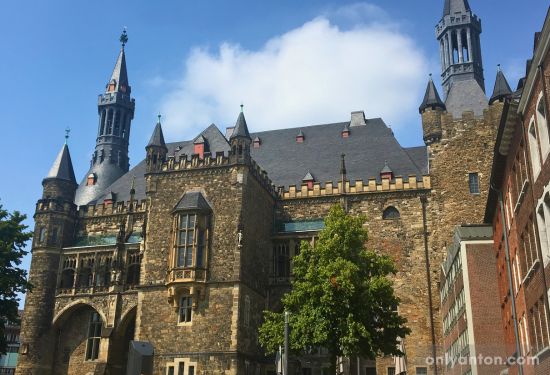
Aachen Cathedral: A Legacy of Charlemagne
The Aachen Cathedral, also known as the Imperial Cathedral, was originally built by Charlemagne in 805 AD. It has been the spiritual heart of Aachen ever since. Designated as a UNESCO World Heritage Site, the cathedral is a masterpiece of medieval architecture and a pivotal pilgrimage site. Its core, the Palatine Chapel, is the oldest part of the structure and reflects the grandeur of Charlemagne’s reign. It features an octagonal basilica in the Carolingian style, adorned with mosaics and marble columns from Rome and Ravenna.
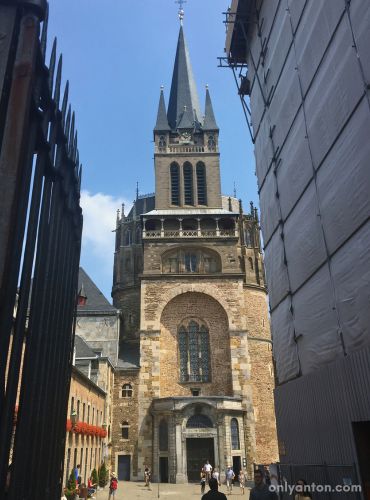
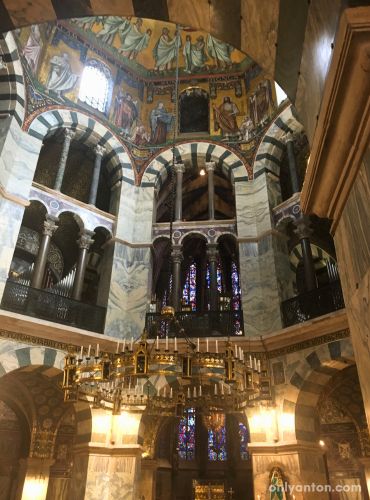
Inside, the cathedral houses the Domschatzkammer (Cathedral Treasury), amongst northern Europe’s most important church treasuries. It contains a wealth of sacred art pieces, including the Cross of Lothair, the Bust of Charlemagne, and the Persephone sarcophagus. The treasury is a testament to the cathedral’s centuries-long importance in European religious and cultural history.
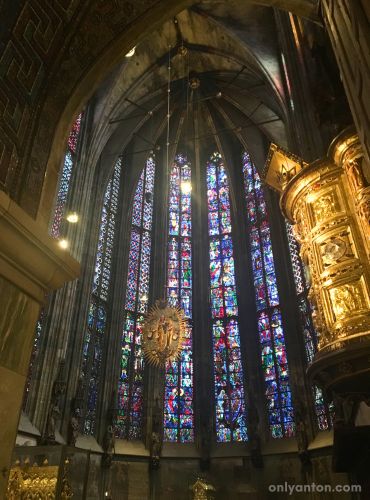
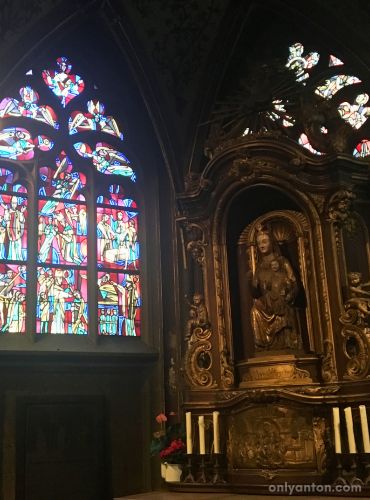
Aachener Rathaus
The Aachener Rathaus, or Aachen Town Hall, is another notable landmark dating back to the 14th century. Built on the remnants of Charlemagne’s palace, the Gothic structure was later embellished with elements of Baroque architecture. It is renowned for its detailed 19th-century frescoes that line the walls of the Coronation Hall, illustrating scenes from Charlemagne’s life and the city’s legendary history. These artworks add to the building’s aesthetic appeal and conserve the narrative of Aachen’s storied past.

The Palace of Aachen
Although not as intact as other landmarks, the Palace of Aachen was once a formidable Carolingian structure where Charlemagne held court. The remains of the palace serve as a reminder of Aachen’s significance during the medieval period. Much of the original palace has been incorporated into later buildings, including the Town Hall. Visiting the site provides a glimpse into the medieval might and the architectural innovation of the era.
Preserving Heritage
Together, these sites are integral to Aachen’s cultural heritage, drawing visitors worldwide. They exemplify the architectural advancements of their respective periods and preserve the legacy of one of Europe’s most historically significant cities. The ongoing conservation efforts ensure that these monuments continue to tell Aachen’s story for generations.
Culinary Delights and Local Specialties of Aachen
Aachen is a city with a rich culinary heritage. It offers an array of unique flavours that testify to its historical and geographical influences. At the forefront of these culinary treasures is the Aachener Printen, a type of gingerbread that has become synonymous with the city’s gastronomic identity.
Aachener Printen: A Taste of History
Aachener Printen is not just a treat; it’s a piece of Aachen’s history baked into a deliciously spiced biscuit. This gingerbread-like confectionery dates back to the 15th century. Printen were initially made by bakers using a mixture of spices brought to Aachen by merchants travelling along the ancient spice routes.
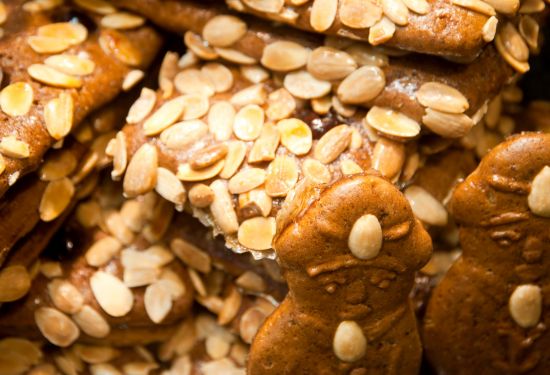
Today, Printen is celebrated for its various forms, from sweet and soft to delightfully crunchy. Some versions are coated in chocolate. Others are embedded with nuts or marzipan. The unique texture and flavour of Printen come from a special syrup made from sugar beets, which is used instead of honey. During the colder months, especially around Christmas, the aroma of these spices fills the air in Aachen, drawing locals and tourists alike to the many bakeries specializing in this traditional treat.
Visitors seeking a deeper understanding of this iconic pastry can explore the Printen Museum. Located within one of the city’s renowned Printen bakeries, the museum offers a fascinating glimpse into the history and production of Printen. Guests can watch live demonstrations, sample various types of Printen, and even take some home as edible souvenirs.
Beyond Printen: Aachen’s Culinary Landscape
While Aachener Printen may be the star, Aachen’s culinary scene is diverse and inviting. The city boasts several local breweries where beer enthusiasts can indulge in craft beers and traditional German brews. Hopfen und Malz is a popular microbrewery in Aachen. Guided tours give visitors a chance to learn about the brewing process and sample freshly brewed ales and lagers.
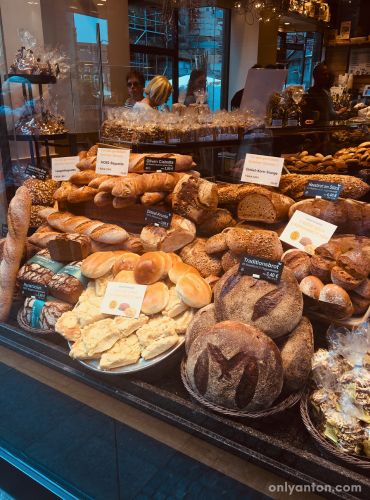
For those looking to experience the local dining culture, Aachen does not disappoint. The city has numerous bistros and restaurants serving everything from traditional German dishes to international cuisine. One must-try dish is the Sauerbraten. This is a pot roast, usually made of beef, but other meats may include lamb, mutton, pork, and traditionally horse. The meat is marinated before slow cooking as a pot roast. The Rheinische Sauerbraten, from the Rhineland region of Aachen, often includes raisins and gingerbread to thicken the sauce and is typically served with red cabbage, potato dumplings, or boiled potatoes.
Seasonal Delights: Aachen’s Food Festivals
Visitors in December are in for a treat. The Aachen Christmas Market is one of the most famous in Germany. It provides a perfect backdrop to enjoy all these culinary offerings. The market is famous for its festive decorations and enchanting atmosphere. It is equally known for the stalls serving hot Printen, mulled wine, and other seasonal delights.
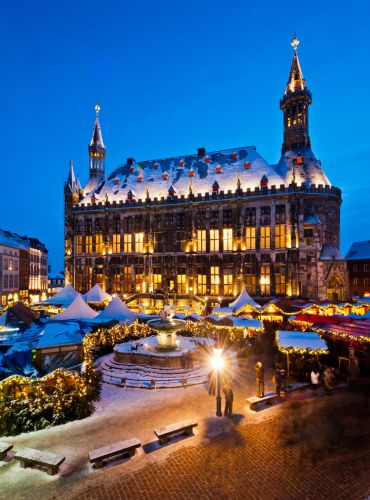
The mulled wine typically available during the Christmas season in Germany is known as Glühwein. It’s a staple at Christmas markets, including the Aachen Christmas Market. Glühwein is made from red wine heated with various spices, such as cinnamon sticks, cloves, star anise, citrus, and sugar. Sometimes, additional ingredients like vanilla pods or cardamom are also used to enhance the flavour. It’s enjoyed for its warming properties and festive spirit, making it a popular choice among visitors looking to embrace the cozy, celebratory atmosphere of the market.
For those visiting outside the Christmas season, Aachen’s culinary scene continues to offer myriad tastes and experiences year-round. Every visitor is sure to leave with satisfied taste buds and a deeper appreciation for the city’s rich culinary heritage.
Modern Attractions and Leisure Activities in Aachen
Although Aachen is steeped in history, it also offers many modern attractions and leisure activities that cater to various interests, making it a vibrant destination year-round.
Cultural Enthusiasts
The Couven Museum is an essential stop for those inclined towards the arts. The museum is housed in a beautifully restored 18th-century building. It showcases domestic life during the Rococo and early Classicism periods, offering a glimpse into the everyday luxuries of Aachen’s past bourgeois. Another cultural gem is the Ludwig Forum for International Art, which hosts a dynamic collection of contemporary art. The museum presents works of art that challenge and engage visitors, from groundbreaking exhibitions to interactive installations, ensuring a memorable experience.
Wellness and Relaxation
The Carolus Thermen offers a modern twist on Aachen’s ancient spa culture. Visitors can unwind in the thermal waters that have drawn people to Aachen for centuries. The facility combines luxurious spa treatments with the therapeutic benefits of its hot mineral springs. Offering a range of wellness activities, from sauna sessions to therapeutic massages, the Carolus Thermen provides a perfect retreat for relaxation and rejuvenation.
Active and Outdoor Adventures
Aachen’s surrounding landscapes offer numerous hiking and cycling paths for those who prefer a more active visit. The city’s proximity to Eifel National Park provides easy access to nature and the great outdoors, where scenic trails and panoramic views await exploration.
These modern attractions, combined with Aachen’s rich historical tapestry, make it a uniquely appealing destination for travellers seeking both cultural depth and contemporary leisure. Whether you’re exploring art galleries, relaxing in thermal baths, or strolling through festive markets, Aachen offers diverse activities that promise to enrich your travel experience.
Conclusion: Discover the Charms of Aachen
Aachen is a city where history and modernity converge in a fascinating blend of past and present. As you wander through its streets, you are walking on the ground that Charlemagne once trod amidst architecture that has witnessed centuries of European history. Yet Aachen is not a city frozen in time. It thrives with vibrant cultural scenes and contemporary attractions that cater to every interest.
From the historical grandeur of Aachen Cathedral and the medieval treasures of the Domschatzkammer to the lively Aachen Christmas Market and the relaxing Carolus Thermen, Aachen offers a unique array of experiences. Its strategic location at the crossroads of Germany, the Netherlands, and Belgium makes it an accessible getaway for travellers eager to explore the rich bounty of European culture and history.
Whether you are a history enthusiast eager to explore ancient sites, a cultural aficionado interested in diverse art forms, or someone looking to unwind in the therapeutic hot springs that have made Aachen famous throughout the ages, this city has something to offer. The blend of architectural marvels, festive atmosphere, and culinary delights ensures that Aachen is not just a stopover but a destination in its own right.
Consider Aachen as a must-visit addition to your European travel itinerary, especially if you are drawn to places that offer an intimate glimpse into the region’s heritage while providing all the comforts and excitement of modern attractions. In Aachen, every step is a story, and every visit is an opportunity to create new memories in a city that beautifully bridges the old with the new.
Join the Conversation and Explore More Hidden Gems
Have you ever wandered the historic streets of Aachen or marvelled at its rich culture and history? If you’ve visited this enchanting city, I’d love to hear about your experiences. What was your favourite spot? Did you try the famous Aachener Printen or soak in the warmth of the Carolus Thermen? Share your stories in the comments below, and let’s celebrate Aachen’s unique allure.
For those intrigued by Aachen’s blend of history and modernity, stay tuned for my upcoming post about Ghent, another hidden gem in Europe where culture and heritage converge in an unforgettable blend of experiences. And if you’re interested in exploring more vibrant European traditions, don’t miss my feature on the Four Days Festival in Nijmegen, available now on the website. Each post is a step further into the heart of Europe’s rich and diverse culture, promising more insights and inspiration for your next adventure.
Your engagement enriches our community and helps fellow travellers discover new destinations and plan their journeys with a touch of local insight. Let’s continue to explore the world together, uncovering more hidden gems and sharing the beauty of travel.
Further Reading and Resources
For those inspired to delve deeper into the history and culture of Aachen or to extend their knowledge of similar European destinations, here are some curated resources and reading materials:
Books:
- Charlemagne: Father of a Continent, (2018) by Alessandro Barbero, Allan Cameron (trans.). A well-regarded and more recent biography written by a distinguished medievalist. Find it online, at a library near you, or get your copy here.
- Charlemagne by Johannes Fried, Peter Lewis (trans.) (2016). A biographical study of the legendary Frankish king and emperor as told by a former Professor of Medieval History from the University of Frankfurt. Look for it online or at a local library. Or purchase a copy from Amazon here.
Blogs and Websites:
- EuroVelo Routes – Discover bike routes that pass through Aachen as part of the larger network of European cycling routes. Explore EuroVelo Routes here.
- Aachener Dom (Cathedral) website. Plenty of information about the cathedral and planning your visit may be found here.
- Wikipedia, “Aachen”: Comprehensive information about the city of Aachen can be found here.
- “Charlemagne,” from the editors at History.com. A detailed historical account of the life and times of Charlemagne. Read the article here.
Local Tourism Boards:
- Aachen Tourist Service: Offers detailed visitor information, guided tours, and special event schedules. Learn more about Aachen tourism here.
Online Articles:
- “In Aachen, the legacy of Charlemagne,” Los Angeles Times (August 2003) by Eva G. Fremont. This article dives into the city’s rich medieval heritage and its ongoing celebration of Charlemagne. Read the article here.
- “Perfect Day in Aachen” by Katja Esser, Aachen Tourist Service Blog. Get a local’s insider tips for visiting Aachen here.
Museums and Cultural Sites:
- Aachener Printen Museum: Discover the history and production of Aachener Printen through interactive exhibits and tastings. Visit the Printen Museum here.
- Ludwig Forum for International Art: For contemporary art enthusiasts, this museum offers a look at modern artistic expressions with a global perspective. Explore the Ludwig Forum here.
- Hopfen + Malz Bierladen (Hops + Malt): Read a blog post about the brewery by the Aachen Tourist Service here. The actual website for Hopfen + Malz is only in German. Find it here.
- Carolus Thermen Bad Aachen: The official website may be found here.
Related Blog Posts:
Delve into another fascinating European city with a rich history and vibrant cultural scene close to Aachen. Read my post about The Four Days Festival in Nijmegen.
These resources will help you gain a deeper understanding of Aachen’s historical and cultural context and offer practical tips for planning your visit. Whether you read books and articles or visit museums, you can enrich your travel experience and discover more about this fascinating region.
Photo Credits
Stock image of the Christmas Market in Aachen by Jotlily from Getty Images/Canva.
Stock image of Aachener Printen (Gingerbread) by 3quarks from Getty Images/Canva.





I’m glad we listened to your suggestion to explore Aachen instead of revisiting Maastricht. Delightful city.
Yes! Aachen was a pleasant surprise.